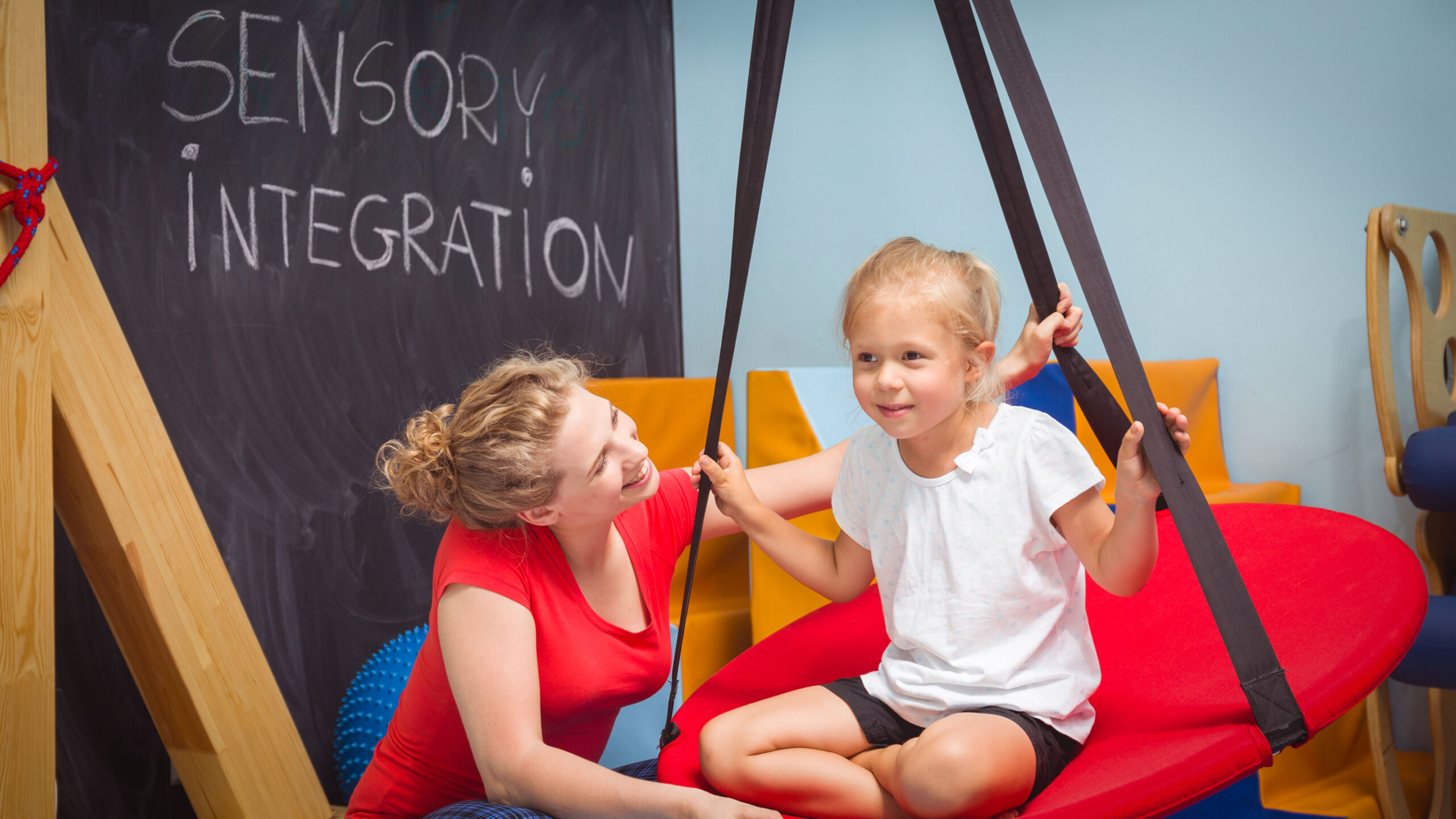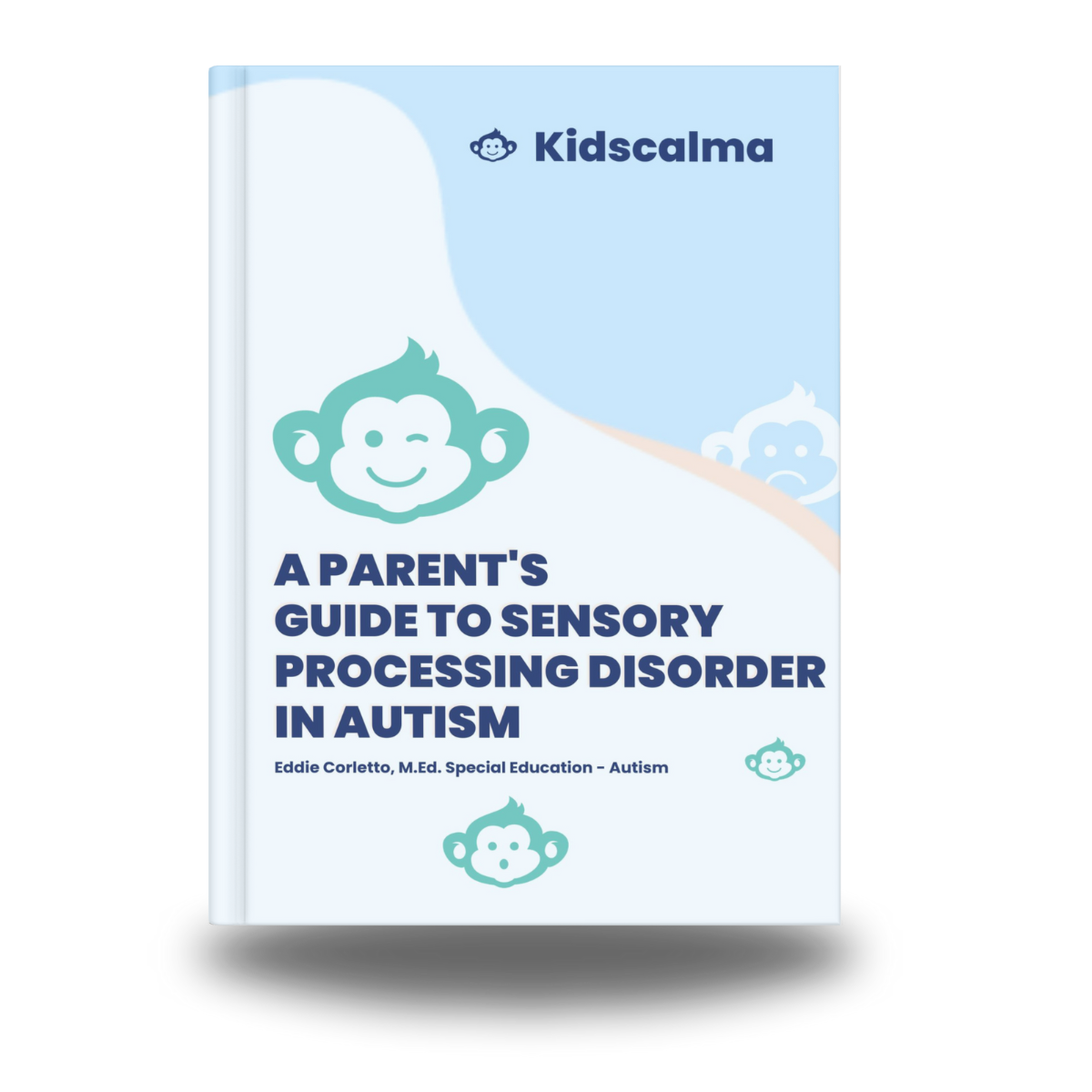A Parent’s Guide to Sensory Processing Disorder in Autism

What is Sensory Processing Disorder?
Sensory processing disorder (SPD), formerly called Sensory Integration Dysfunction (SID), is a neurological condition that affects the brain’s ability to process information from the senses. This can lead to many challenges such as: body awareness, fine motor skills, motor control, social interactions, emotional regulation, and behavior. Such challenges can lead to developmental delays, and is often seen in children with autism spectrum disorders (ASD). It is worth nothing that it can also occur in children without ASD.
Children with SPD may have trouble processing information from one or more of their senses and experience sensory overload. This can make it difficult for them to participate in everyday activities, such as socializing with their peers, eating, or simply dressing themselves. For example, a child with SPD may be sensitive to certain textures of food and clothing. They may not be able to remain in a gym, or restaurant and socialize because it is simply too noisy for them. Attending to an academic tasks can be difficult because the lights in the classroom are just visually screaming at them.
Did you Know That There Are Eight Senses, not Five?
The human body’s sensory system is made up of eight senses, not five. We are all familiar with the five external ones: Auditory, visual, tactile, olfactory, and the gustatory sense. These senses work together to help us perceive and interact with the physical environment around around us. Information is constantly being collected by them and sent to the brain where it processes it and formulates appropriate responses to the stimuli. Allowing us to interact with the immediate physical environment.
The Three Internal Senses
The three internal senses are vestibular, proprioceptive, and interoceptive. The vestibular sense allows us to balance and stay up-right. The proprioceptive sense helps us understand where our bodies are in relationship to the environment surrounding us. The least known of the eight senses is the interoceptive sense. This sense is equally as important as it provides us with feedback of when we are full, hungry, or thirsty. It also regulates our sleep, and lets us know when we need to go to the bathroom.
SPD is thought to be caused by a combination of genetic and environmental factors. Some children are more likely to develop SPD if they have a family history of the condition. Certain environmental factors, such as premature birth or exposure to toxins, can also increase the risk of SPD.
How Kids With SPD Respond To Sensory Stimuli
Hypersensitivity Respond To Stimuli
Children with SPD may exhibit hypersensitivity to various sensory stimuli. Hypersensitivity, also known as sensory over-responsivity, refers to an exaggerated response to sensory input. For example, a child may be overly sensitive to florescent lights, loud noises, or certain textures. They may become overwhelmed or distressed in environments with excessive sensory stimulation.
Hyposensitivity Respond To Stimuli
On the other hand, hyposensitivity, also called sensory under-responsivity, refers to a decreased response to sensory input. A child with hyposensitivity may have low pain threshold and may not react to pain or temperature changes as expected.
In addition to hypersensitivity and hyposensitivity, children with SPD may also have difficulty modulating their responses to sensory input. They may overreact to minor sensory stimuli or underreact to significant stimuli.
I learned this when my teenage autistic son was just a little boy. He fell from the bed and he did not cry. I was so proud of him for not crying, but at the same time, it did not make sense. I did not know any better. That was the first sign that kicked me in the rear and led me down to the Autism and SPD rabbit hole. Little did I know that my son would go on growing up with a high tolerance for pain.

What Are The Common Signs Of Sensory Processing Disorder
There are many common signs of sensory processing disorder (SPD), and they can vary depending on the individual. Some of the most common signs include:
1. Oversensitivity to light, sound, or touch
Children with Sensory Processing Disorder may be overly sensitive to certain sensations, such as bright lights, loud noises, or rough textures. This can make it difficult for them to participate in everyday activities, such as going to school or playing with friends.
2. Difficulty with motor coordination and balance
Children with Sensory Processing Disorder may have difficulty with motor coordination and balance. This can make it difficult for them to walk, run, catch a ball, or have trouble climbing stairs. They may also have trouble with fine motor skills, such as writing or using scissors.
3. Problems with social interaction and communication:
Children with Sensory Processing Disorder may have difficulty interacting with others. They may not understand social cues, and they may have trouble expressing themselves. This can make it difficult for them to make friends and succeed in school.
4. Difficulty paying attention and focusing:
Children with SPD may have difficulty paying attention and focusing. They may be easily distracted, and they may have trouble following instructions. This can make it difficult for them to learn in school and succeed in other activities.
Early diagnosis and intervention
can make a big difference in the lives of children with SPD. If you think your child may have SPD, it’s important to seek professional help. A qualified therapist can evaluate your child and develop a treatment plan or sensory diet that meets their individual needs.
What are Some of the Difficulties Children with Sensory Processing Disorder Experience?
Children with sensory processing disorder (SPD) may experience difficulties in various areas of their everyday lives due to challenges in receiving and responding to sensory information. Some common difficulties they face include:
Social interactions and communication:
Children with Sensory Processing Disorder may struggle to understand social cues and interact appropriately with others. They may have difficulty understanding the tone of voice, facial expressions, and body language of others, which can lead to misunderstandings and social isolation.
Learning and academic performance:
SPD can impact a child’s ability to learn and perform well in school. They may have difficulty paying attention, following instructions, and completing tasks that require sensory processing skills, such as reading, writing, and math.
Sensory sensitivities and aversions:
Children with Sensory Processing Disorder may be overly sensitive or averse to certain sensory stimuli, such as loud noises, bright lights, certain textures, or strong smells. This can make it challenging for them to participate in everyday activities and can lead to anxiety and distress.
Motor coordination and balance:
SPD can affect a child’s motor coordination and balance. They may have difficulty with tasks that require fine motor skills, such as handwriting or using utensils, and may also experience problems with gross motor skills, such as walking, running, and climbing stairs.
Emotional regulation:
Children with SPD may struggle to regulate their emotions and may experience frequent meltdowns or tantrums. They may also have difficulty calming themselves down and transitioning between activities.
Behavioral challenges:
SPD can lead to various behavioral challenges, such as impulsivity, hyperactivity, and aggression. Children with SPD may also have difficulty following rules and routines and may engage in repetitive behaviors.
It’s important for parents and caregivers to understand the unique challenges faced by children with sensory processing disorder and to seek appropriate support and intervention to help them thrive. Early diagnosis and intervention can significantly improve the outcomes for children with SPD, enabling them to develop the skills they need to fully participate in and enjoy their daily lives.

Diagnosing sensory processing disorder
Involves a collaborative effort between parents, healthcare professionals, and sometimes educators. Occupational therapists (OTs) play a crucial role in the assessment and diagnosis of SPD. They use a variety of tools and techniques to evaluate a child’s sensory processing skills, including standardized tests, observations, and interviews with the child and their parents.
What Standardized Testing Tools Are Used In The Assessment Process?
Sensory Processing Disorder (SPD) is typically diagnosed by an occupational therapist through a process that includes a sensory integration evaluation. This evaluation aims to understand how an individual’s nervous system responds to sensory stimuli from the five traditional senses: sight, hearing, touch, smell, and taste. The occupational therapist observes the individual’s reactions to various sensory experiences and may use standardized assessment tools and checklists to gather information about the individual’s sensory processing patterns.
Parents' And Caregivers' Participation In The Assessment Process
Parents and caregivers often play a crucial role in the diagnostic process by providing detailed information about the child’s behaviors and responses to sensory stimuli in different environments. They may be asked to fill out questionnaires or checklists that describe their child’s sensory preferences and aversions
Sensory Integration and Praxis Tests (SIPT):
The SIPT is widely considered a comprehensive and standardized assessment tool for evaluating sensory integration and praxis (motor planning) functions in children from 4 years to 8 years and 11 months old. It consists of 17 subtests designed to measure sensory integration processes that underlie learning and behavior. The administration of the entire test generally takes about 2.5 hours, and it requires the examiner to follow specific procedures. Due to its comprehensive nature and the level of detail it provides, the SIPT has long been called the “Gold Standard” of sensory processing assessment tools.
Sensory Processing 3-Dimensions Scale (SP3D):
The SP3D is a newer assessment tool developed to assess sensory modulation by rating three atypical behavioral response patterns across the visual, auditory, tactile, proprioceptive, and vestibular domain.
It evaluates both sensory modulation and sensory discrimination through subtests in each of the five sensory domains. The SP3D has shown promise for evaluating children from 3 to 13 years of age and for all subtypes of SPD, making it a valuable tool for guiding the delivery of appropriate occupational therapy interventions.
Evaluation in Ayres Sensory Integration (EASI):
The EASI is a recent development in the field of sensory processing assessment. It builds on the research base of the SIPT and evaluates multiple aspects of sensory integration, including tactile perception, visual perception, motor planning, praxis, and more. Designed to be open access and available to OT practitioners with the required training, the EASI aims to provide a comprehensive evaluation of sensory integration functions. It is considered the most current and internationally recognized means of standardized assessment for children with sensory processing challenges
Early diagnosis and intervention are essential for children with SPD
Early intervention can help children develop the skills they need to participate in everyday activities and reduce the impact of Sensory Processing Disorder on their lives. If you think your child may have Sensory Processing Disorder, it is important to seek professional help as soon as possible.
Treatment options for sensory processing disorder
(SPD) vary depending on the severity of the condition and the individual child’s needs. The main treatment options include sensory integration therapy, occupational therapy, physical therapy, and speech therapy.
Sensory integration therapy
Sensory integration therapy is a type of therapy that helps children with Sensory Processing Disorder learn how to process sensory information more effectively. This therapy typically involves activities that help children develop their sensory processing skills, such as swinging, jumping, and playing with textured objects.
Occupational therapy
Occupational therapy is another type of therapy that can help children with Sensory Processing Disorder. Occupational therapists work with children to develop the skills they need to perform everyday activities, such as eating, dressing, and playing. They may also use sensory integration techniques to help children improve their sensory processing skills.
Physical Therapy
Physical therapy can also be helpful for children with SPD. Physical therapists work with children to improve their motor skills, such as balance, coordination, and strength. They may also use sensory integration techniques to help children improve their sensory processing skills.
Speech Therapy
can be helpful for children with Sensory Processing Disorder who have difficulty speaking or understanding language. Speech therapists work with children to develop their speech and language skills. They may also use sensory integration techniques to help children improve their sensory processing skills.
It is important to note that there is no one-size-fits-all treatment for Sensory Processing Disorder. The best treatment plan for a child with Sensory Processing Disorder will vary depending on the child’s individual needs. Early diagnosis and intervention are essential for children with SPD. Early intervention can help children develop the skills they need to participate in everyday activities and reduce the impact of Sensory Processing Disorder on their lives.
Conclusion

As we navigate the complexities of Sensory Processing Disorder (SPD) in children, particularly those on the autism spectrum disorder, it’s crucial for parents, educators, and therapists to approach this journey with empathy, understanding, and a commitment to providing the support these exceptional children need to thrive. The journey with SPD is unique for every child and family, but with early diagnosis, personalized intervention, and a nurturing environment, children can develop the skills necessary to navigate their sensory world more effectively.
Author Bio

Hey there! I’m Eddie Corletto, the passionate mind behind kidscalma.com. A proud father of an autistic teenager. A special education teacher with over ten years of experience in the classroom. I hold a master’s degree specializing in Autism and Sensory Processing Disorders. I am deeply committed to supporting autistic children and their families. Kidscalma is my platform to share both my professional and personal experiences. I specialize in creating helpful resources for parents and educators supporting children on the Autism spectrum, Sensory Processing Disorder, and other learning disabilities. When I’m not in my classroom or writing, you might catch me hiking with my family or cycling around the scenic roads of California’s Central Coast. I believe our children can achieve amazing things every day. Connect with me on Facebook or subscribe to my blog for more insights and resources!

A PARENT’S GUIDE TO SENSORY PROCESSING DISORDER IN AUTISM
Eddie Corletto, M.Ed. Special Education
Published April 23, 2024
Like and Follow us on Facebook Page and visit may our Amazon Store
Other blogs
Sensory Overload in Autism and SPD: A Parent’s Guide
Sensory Overload Sensory overload is a term that resonates deeply with parents of exceptional children. It describes a state where the brain...
Why Autism Head Banging Happens and how to Help?
Navigating the challenges of self-injurious behaviors (SIBs), including head banging behavior, can be emotionally challenging for families of...
Why are Sensory Swings Essential for Kids With Autism?
A therapy swing, also known as a sensory swing, like the one shown by Kidscalma, is a tool that helps manage Sensory Processing Disorders. It does...
How Weighted Lap Pads Calm Sensory Overload?
It can be hard to deal with sensory problems in autistic children. But with tools like the weighted lap pad from Kidscalma, we can make them feel...
Toilet Training Autistic Children
Toilet training autistic children can be an overwhelming process, and it often brings an additional layer of challenges. If you’re feeling uncertain...
